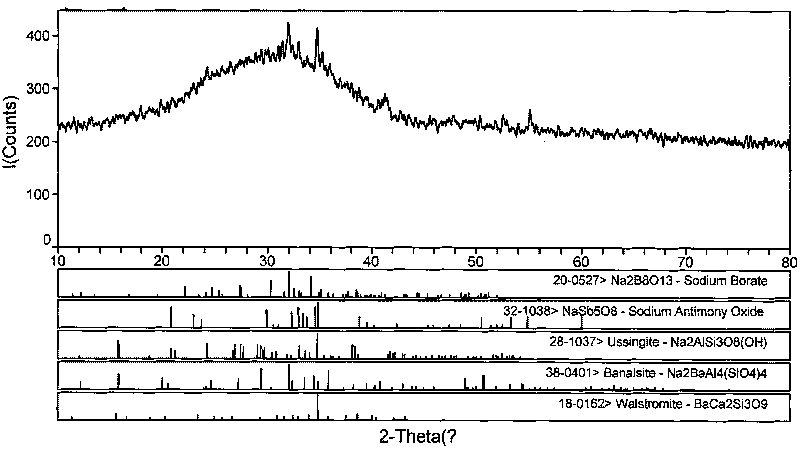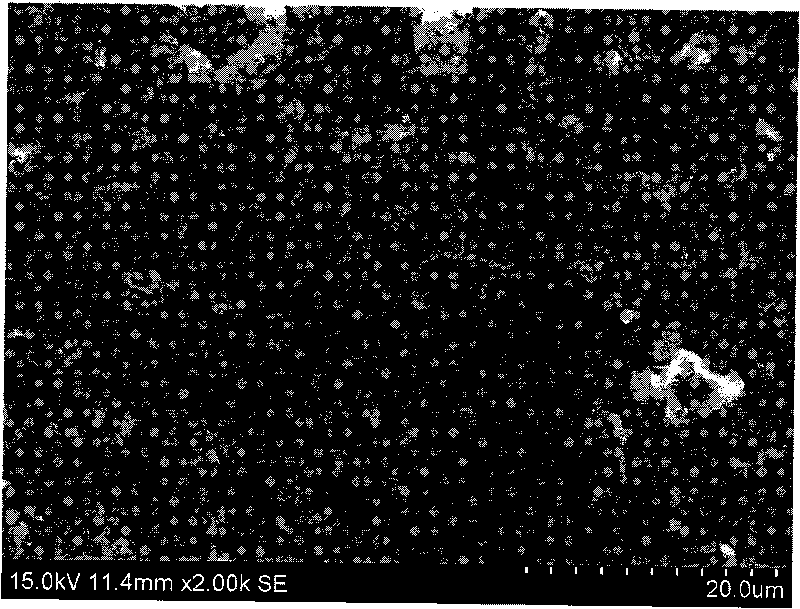Method for producing microcrystalling foam glass with gold tail ore
A technology for microcrystalline foam glass and gold tailings, which is applied in the field of foam glass manufacturing, can solve the problems of low overall strength of foam glass, and achieve obvious economic and environmental benefits, protect the environment, and reduce production costs.
- Summary
- Abstract
- Description
- Claims
- Application Information
AI Technical Summary
Problems solved by technology
Method used
Image
Examples
Embodiment 1
[0017] Embodiment 1, 1) at first, be the gold tailings powder of 68% by mass fraction, the waste glass powder of 12%, the fluorite powder of 5.5%, the sodium nitrate powder of 4%, the calcite powder of 5% , 5% soda ash powder, 0.3% sodium fluorosilicate powder and 0.2% antimony trioxide powder are put into the mixer and mixed evenly;
[0018] 2) Next, use a screw feeder to put the batch material into the glass furnace, and melt it through the fuel flame. When the batch material forms glass at 1250 ° C, it will pass through the feeding channel to drain the molten glass liquid into the pool for further processing. water quenching;
[0019] 3) Then, the water-quenched glass is pulled out, put into a ball mill after being dried in a dryer, and ball-milled through a 150-mesh sieve to make glass powder;
[0020]4) Finally, according to the mass fraction, take 91% glass powder, 2% carbon powder, 5% ammonium dihydrogen phosphate, 1% ferric oxide and 1% manganese dioxide powder and pl...
Embodiment 2
[0026] Embodiment 2, 1) at first, be the gold tailings powder of 70% by mass fraction, the waste glass powder of 10%, the fluorite powder of 10%, the sodium nitrate powder of 2%, the calcite powder of 2% 5.4% soda ash powder, 0.1% sodium fluorosilicate powder and 0.5% antimony trioxide powder are put into the mixer and mixed evenly;
[0027] 2) Next, use a screw feeder to put the batch material into the glass furnace, and melt it through the fuel flame. When the batch material forms glass at 1260 ° C, it will pass through the feeding channel to drain the formed molten glass into the pool for further processing. water quenching;
[0028] 3) Then, the water-quenched glass is pulled out, put into a ball mill after being dried in a dryer, and ball-milled through a 150-mesh sieve to make glass powder;
[0029] 4) Finally, according to the mass fraction, take 90% glass powder, 3% calcium carbonate, 5% ammonium dihydrogen phosphate, 1% ferric oxide and 1% manganese dioxide powder an...
Embodiment 3
[0035] Embodiment 3, 1) at first, be the gold tailings powder of 65% by mass fraction, the waste glass powder of 15%, the fluorite powder of 3%, the sodium nitrate powder of 6%, the calcite powder of 8% 2% soda ash powder, 0.8% sodium fluorosilicate powder and 0.2% antimony trioxide powder are put into the mixer and mixed evenly;
[0036] 2) Next, use a screw feeder to put the batch material into the glass furnace, and melt it through the fuel flame. When the batch material forms glass at 1320 ° C, it will pass through the feeding channel to drain the formed molten glass into the pool for further processing. water quenching;
[0037] 3) Then, the water-quenched glass is pulled out, put into a ball mill after being dried in a dryer, and ball-milled through a 150-mesh sieve to make glass powder;
[0038] 4) Finally, according to the mass fraction, take 94.5% glass powder, 0.5% calcium carbonate, 4% ammonium dihydrogen phosphate, 0.5% ferric oxide and 0.5% manganese dioxide powd...
PUM
| Property | Measurement | Unit |
|---|---|---|
| Apparent density | aaaaa | aaaaa |
| Flexural strength | aaaaa | aaaaa |
| Apparent density | aaaaa | aaaaa |
Abstract
Description
Claims
Application Information
 Login to View More
Login to View More - R&D
- Intellectual Property
- Life Sciences
- Materials
- Tech Scout
- Unparalleled Data Quality
- Higher Quality Content
- 60% Fewer Hallucinations
Browse by: Latest US Patents, China's latest patents, Technical Efficacy Thesaurus, Application Domain, Technology Topic, Popular Technical Reports.
© 2025 PatSnap. All rights reserved.Legal|Privacy policy|Modern Slavery Act Transparency Statement|Sitemap|About US| Contact US: help@patsnap.com



